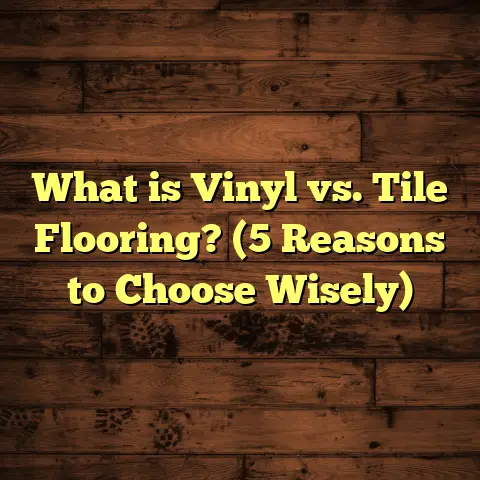What is Glass Flooring? (5 Stunning Benefits You Need to Know)
I once helped a client transform a dull, cramped loft into a bright, open space that felt miles bigger than before. The secret? Glass flooring. It’s a unique flooring choice that completely changed how light and space worked in that room. If you’ve never thought about glass floors for your home or office, you might be missing out on an exciting option.
What is Glass Flooring?
So, what exactly is glass flooring? Simply put, it’s a type of flooring made from specially treated glass panels designed to be strong and safe enough to walk on. Unlike regular glass you might find in windows, these panels are often laminated or tempered for durability. They can be clear, frosted, textured, or even colored, depending on the design and purpose.
Glass flooring is used in various settings—from modern homes to commercial spaces like malls, museums, and offices. The glass panels are usually supported by metal frames or embedded into concrete or wooden subfloors. Sometimes, glass tiles are set into traditional flooring materials to create interesting patterns or allow light to pass through different levels of a building.
I remember the first time I installed a glass floor for a designer client. They wanted something that would literally brighten up the basement below by allowing natural light to filter through from the upper floor. The effect was stunning and completely changed how the space felt—airy, open, and futuristic.
Let me break down some basic types of glass flooring you might encounter:
- Laminated Glass Flooring: Two or more layers of glass bonded with an interlayer making it very strong and safe. If it breaks, it holds together rather than shattering.
- Tempered Glass Flooring: Glass that’s been heat-treated to increase its strength. It breaks into small chunks rather than sharp shards.
- Textured or Patterned Glass: Offers slip resistance and aesthetic variety.
- Colored or Frosted Glass: Used for privacy or design accents.
Glass floors may be installed as full panels covering an entire room or as smaller tiles integrated with other flooring materials for creative effects.
1. Dramatic Light Amplification
One of the biggest benefits I’ve seen with glass floors is how much natural light they can bring into a space. Unlike wood or tile floors that block light, glass lets it pass through.
In one project, a dark staircase landing was transformed by installing thick glass panels instead of solid wood steps. The daylight from a skylight above poured down through the steps and lit up the floor below. It made the whole area feel more inviting and less claustrophobic.
Studies show that increasing natural light exposure can improve mood and productivity, so this isn’t just about aesthetics—it’s about creating healthier indoor environments too.
Why Does Light Matter So Much?
Natural light has a huge effect on our well-being. Research from the Harvard T.H. Chan School of Public Health shows that people exposed to more daylight at work report better sleep quality and feel more energized throughout the day.
Also, spaces with good daylight tend to look bigger and more welcoming. In homes I’ve worked on where glass floors were installed near windows or skylights, there was a clear difference in how bright and spacious rooms felt compared to rooms with opaque flooring.
How Glass Floors Make a Difference
Because glass is transparent, even when you’re standing on it, light passes through without obstruction. This allows areas beneath the glass floor—like basements, stairs, or lower-level rooms—to receive daylight they wouldn’t get otherwise.
I had a client with a basement that always felt like a dungeon—no windows and no natural light at all. We installed thick laminated glass panels in part of the main floor above to let sunlight travel down. The difference was night and day (literally). The basement became usable as a workspace instead of just storage.
Technical Insight: Light Transmission Rates
Not all glass transmits light equally. Clear laminated glass can transmit around 90% of visible light depending on thickness and coatings. Frosted or tinted glass transmits less but still more than opaque materials.
Selecting the right type depends on your priorities—maximizing brightness or adding privacy while still letting some light through.
2. Unique Aesthetic Appeal
Glass flooring adds a modern and sleek look that’s hard to match with other materials. Whether you want a minimalist style or something bold with textured or colored glass, it offers design flexibility.
I once worked on a commercial office where the client wanted to showcase the building’s original brick foundation beneath the floor. We installed thick glass panels over the bricks, creating a “floor window” effect. Employees loved seeing the history beneath their feet every day. It became a conversation starter and gave the office character.
Design Possibilities Are Limitless
Glass floors don’t have to be plain or boring. You can customize color, texture, and pattern:
- Colored Glass: Adds warmth or cool tones depending on your decor.
- Etched or Frosted Patterns: Create privacy zones or artistic designs.
- Embedded Materials: Some designers embed objects like shells or LED lights within the layers for dramatic effects.
- Backlit Glass Floors: Installing lighting beneath glass panels can turn floors into glowing surfaces at night—a real showstopper.
In one home renovation I handled, we used backlit frosted glass tiles in a hallway that doubled as an art gallery. The illuminated floor guided visitors through the space like stepping stones of light.
How Does Glass Flooring Fit Different Styles?
From sleek industrial lofts to luxury penthouses, glass floors can adapt easily:
- For minimalist spaces, clear polished glass fits perfectly.
- In rustic or vintage designs, textured or frosted glass can soften the modern feel.
- Commercial spaces often use patterned or colored glass for branding or thematic purposes.
3. Durability and Safety
You might worry that walking on glass sounds risky. But modern glass flooring is engineered with safety in mind. Tempered or laminated glass can withstand heavy loads and impacts, often rated to hold thousands of pounds per square foot.
What Makes Glass Floors Strong?
The magic lies in how the glass is treated:
- Tempered Glass is heated then rapidly cooled during manufacturing. This process compresses the surfaces and makes it about four to five times stronger than regular glass.
- Laminated Glass sandwiches an interlayer (usually made of polyvinyl butyral) between two or more sheets of glass. Even if it cracks, it holds together like safety windshields in cars.
Together these treatments ensure that floors will not easily break under typical household or commercial use.
Industry Standards Ensure Safety
In commercial projects I’ve consulted on, we always refer to standards like ASTM E1300 (Standard Practice for Determining Load Resistance of Glass in Buildings) which specifies minimum thicknesses and load ratings.
For example:
| Thickness (inches) | Approximate Load Capacity (lbs/sq ft) |
|---|---|
| 0.5 | 2500 |
| 0.75 | 4500 |
| 1 | 7000 |
This means even relatively thin panels can hold heavy furniture and foot traffic safely.
Slip Resistance Considerations
One concern many clients have is whether glass floors are slippery when wet. That’s a valid question because smooth glass can be slick.
To combat this:
- Textured surfaces can be sandblasted or etched.
- Anti-slip coatings are available.
- Frosted finishes also improve grip.
I always recommend discussing these options with your installer based on where the floor will be placed (indoor/outdoor, high traffic areas).
4. Easy Maintenance and Longevity
Glass floors are surprisingly easy to keep clean compared to porous materials like wood or stone. A simple wipe with glass cleaner keeps them sparkling without stains or wear marks.
Cleaning Tips I Share Often
Because glass doesn’t absorb dirt or liquids like wood or carpet,
- Dusting regularly prevents grit buildup that could scratch.
- Wiping spills immediately avoids sticky residue.
- Use non-abrasive cleaners specifically made for glass surfaces.
I’ve seen clients keep their floors looking brand new for years just by following these simple steps.
Longevity Compared to Other Floors
Over time:
- Wood may scratch, warp, or fade.
- Carpet stains easily and wears unevenly.
- Vinyl can peel or dent under heavy use.
- Tile grout requires regular scrubbing.
Glass flooring resists these issues when properly installed and maintained.
One retail store I worked with replaced their original tile floor with laminated glass five years ago. It still looks pristine despite heavy daily foot traffic from hundreds of shoppers.
5. Space Enhancement and Illusion of Openness
Glass floors can visually expand spaces by creating transparency between different levels or areas.
One client with a small urban apartment wanted to feel like their place was larger than it actually was. We installed translucent glass panels in certain zones, which allowed them to see through parts of the floor to storage spaces below. This clever use of glass tricked the eye and made their compact home feel more open without sacrificing functionality.
Architects often use glass flooring in narrow corridors or between floors to maximize perceived space without adding square footage.
How Does This Work Psychologically?
Our brains interpret transparent areas as continuous space beyond the immediate surface. So when you walk on a clear panel over another room or stairwell below, your mind perceives depth rather than a flat barrier.
This effect can reduce feelings of confinement common in small rooms or basements.
Practical Uses for Space Enhancement
- Skylight floors over staircases brighten both levels.
- Glass platforms in galleries create “floating” exhibits.
- See-through balcony floors maintain views while protecting safety.
- Raised floors with transparent panels reveal mechanical systems below for easy access without compromising aesthetics.
Deep Dive: Cost Factors & Budgeting Insights
Glass flooring isn’t usually cheap upfront compared to traditional materials like hardwood or vinyl—but understanding what drives costs helps plan better.
What Determines Glass Flooring Cost?
- Type & Thickness of Glass: Thicker laminated panels cost more but offer higher strength.
- Size & Complexity: Custom shapes or large spans require more fabrication.
- Support Framework: Metal framing or subfloor reinforcement adds expenses.
- Installation Labor: Skilled labor is essential; this isn’t a DIY project unless you’re experienced.
- Additional Treatments: Texturing, coatings, anti-slip finishes increase price.
- Waste Factor: Cutting panels leads to some material loss; budget must include this margin.
Using FloorTally for Accurate Estimates
Whenever I take on a new flooring job involving glass or any other material, I rely on FloorTally to crunch the numbers for me. It’s been a huge time-saver in estimating costs accurately based on local labor rates and material prices.
For example, glass flooring installation can vary widely depending on thickness, type of support system, and site conditions. FloorTally lets me input all those details along with waste factors so I don’t get blindsided by unexpected expenses.
It also helps me compare options side-by-side—say tempered versus laminated glass—by showing total costs clearly. This way, I can offer clients realistic budgets without guesswork.
FloorTally’s interface is straightforward enough for DIYers but detailed enough for contractors like me who need precise estimates fast.
Typical Cost Range
Based on recent projects and market data:
| Flooring Type | Estimated Cost per sq ft (installation included) |
|---|---|
| Basic Laminated Glass | $50 – $80 |
| Tempered Glass | $60 – $90 |
| Textured/Frosted | $70 – $100 |
| Custom Backlit | $100+ |
For comparison:
| Traditional Flooring | Estimated Cost per sq ft (installation included) |
|---|---|
| Hardwood | $8 – $15 |
| Laminate | $3 – $8 |
| Vinyl | $2 – $7 |
| Tile | $5 – $12 |
Considering longevity and unique benefits, some clients see glass flooring as an investment rather than just an expense.
Case Studies & Real-Life Examples
Case Study 1: Museum Floor Over Archaeological Site
A museum I advised installed over 500 square feet of reinforced laminated glass flooring above an excavation site inside their building. The objective was allowing visitors to walk safely while viewing artifacts underneath without damaging them.
The installation used 1-inch thick laminated panels supported by steel framing hidden beneath trim moldings for clean aesthetics.
Visitor feedback was overwhelmingly positive; many said walking “on history” was memorable and educational.
Case Study 2: Urban Loft With Skylight Floor Panels
In an urban apartment renovation, skylight-style floor panels were installed above a stairwell leading to the basement workspace below.
The panels were tempered clear glass with anti-slip etching spaced evenly across the landing area.
Daylight from overhead windows flooded both levels helping reduce electricity usage during daytime hours by approximately 25%. The client reported feeling less stressed working in the basement due to improved natural light conditions.
Case Study 3: Retail Store Front Desk Feature Floor
A retail store wanted a unique design element at their entrance to impress customers instantly.
We installed backlit frosted glass tiles covering about 100 square feet near the reception desk area, wired with LED lights programmed for different colors during events/sales promotions.
The effect was stunning—customers frequently complimented this feature which added brand personality while maintaining easy cleaning routines for staff.
Comparison With Other Flooring Options
How does glass flooring stack up against hardwood, laminate, vinyl, tile—and even specialty options?
| Feature | Glass Flooring | Hardwood | Laminate | Vinyl | Tile |
|---|---|---|---|---|---|
| Light Transmission | High (up to 90%) | None | None | None | None |
| Durability | High (tempered/laminated) | Moderate (prone to scratches) | Moderate (scratch-resistant but less durable) | Moderate (susceptible to dents) | High (hard and scratch-resistant) |
| Maintenance | Easy (wipe clean) | Moderate (requires polishing) | Easy | Easy | Moderate (grout cleaning) |
| Aesthetic Flexibility | Very high (color/texture options) | High | Moderate | Moderate | High |
| Slip Resistance | Variable (can be treated) | High | Moderate | High | Variable |
| Installation Cost | High | High | Low | Low | Moderate |
| Longevity | Very high | High | Moderate | Moderate | Very high |
| Space Enhancement | Excellent (transparency) | None | None | None | None |
Final Thoughts on Glass Flooring
Have you ever thought about using glass flooring in your home or office? If you want to brighten rooms naturally or make an architectural statement that’s truly your own, it’s worth exploring this option further.
From my hands-on experience installing these floors to analyzing costs with tools like FloorTally, I can say it’s one of the most exciting flooring choices around right now.
If you’re curious about how this material could work for your space—whether for practical reasons like improving light flow and space perception or just for wow-factor design—I’m happy to share more insights based on my projects and research.
Glass flooring isn’t just about looks; it’s about changing how we experience our environments underfoot every day.





